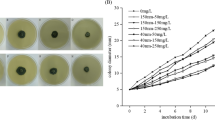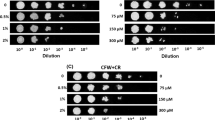Abstract
Sclerotia and mycelium ofPhymatotrichum omnivorum were exposed to anhydrous ammonia (NH3) and then observed with an electron microscope in order to determine the effects of the NH3 treatment on the fungal membranes. Sclerotia were exposed to four rates of NH3: 28, 56, 84, and 112 μg NH3/ml of air for 24 hours. At 28 μg/ml, the plasmalemma became wavy and the mitochondrial cristae began to swell and disperse. At 56 μg NH3/ml the plasmalemma showed breakage and formation of vesicles, and all other membrane systems within the cell were broken and distorted. All membranes were totally disrupted and no organelles were recognizable at 84 μg NH3/ ml.
Mycelium was exposed to 2, 4, 8, 20, and 40 μg NH3/ ml for one minute. Damage to cell membranes was not observed at NH3 cone. up to 4 μg/ ml. At 8 μg NH3/ ml the plasmalemma was broken and the mitochondria were disrupted. At 20 μg/ ml and above, all internal organization was destroyed.
Similar content being viewed by others
References
Henis, Y. & Chet, I., 1967. Mode of action of ammonia on Sclerotium rolfsii. Phytopathology 57: 425–427.
Ito, S., 1962. Light and electron microscopic study of membranous cytoplasmic organelles. In: Interpretation of Ultra-structure. ed. T. J. C. Harris. Academic Press, New York NY.
James, D. W. & Harward, M. E., 1964. Competition of NH3 and H2O for adsorption sites on clay minerals. Soil Sci. Soc. Amer. Proc. 28: 636–640.
Levin, Y. K., Lee, A. G., Birdsall, N. J. M., Metcalfe, J. C. & Robinson, J. D., 1973. The interaction of paramagnetic ions and spin labels with lecithin bilayers. Biochem. Biophys. Acta 291: 592–607.
Miyamoto, V. K. & Stoeckenius, W., 1970. Preparations and characteristics of lipid vesicles. J. Memb. Sci. 5: 252.
Neal, D. C, Wester, R. E. & Gunn, K. C., 1933. Growth of the cotton root-rot fungus in synthetic media and the toxic effect of ammonia on the fungus. J. Agric. Res. 47: 107–108.
Poovaiah, B. W. & Leopold, A. C., 1976. Effects of inorganic salts on tissue permeability. Plant Physiol. 58: 182–185.
Rehfeld, D. W. & Jensen, R. G., 1973. Metabolism of separated leaf cells. III. Plant Physiol. 52: 17–22.
Rush, C. M., 1981. Studies on the use of anhydrous ammonia as a control for Phymatotrichum omnivorum on cotton and its possible mode of action. Ph.D. Dissertation, Tex. A & M Univ., College Station. 105 pp.
Rush, C. M. & Lyda, S. D., 1978. Anhydrous ammonia fumigation of Phymatotrichum infested montmorillonite clay. Proc. Beltwide Cotton Prod. Res. Conf. pp. 23–25.
Rush, C. M. & Lyda, S. D., 1978. The effects of anhydrous ammonia on the germination of Phymatotrichum omnivorum sclerotia. Phytopathol. News 12: 122 (Abstr.).
Rush, C. M. & Lyda, S. D., 1979. Cellular effects of anhydrous ammonia of Phymatotrichum omnivorum sclerotia. Phytopathology 69: 1004 (Abstr.)
Rush, C. M. & Lyda, S. D., 1980. Viability of Phymatotrichum omnivorum in/ on cotton roots treated with anhydrous ammonia. Proc. Beltwide Cotton Prod. Res. Conf. 40: 25–26.
Rush, C. M. & Lyda, S. D., Phymatotrichum membrane stability after exposure to different concentrations of anhydrous ammonia. Proc. Beltwide Cotton Prod. Res. Conf. (In press).
Singer, S. J., 1974. The molecular organization of membranes. Ann. Rev. Biohcem. 43: 805–834.
Tanford, C., 1973. The Hydrophobic Effect: Formation of Micelles and Biological Membranes. John Wiley and Sons, Inc., New York.
Vines, H. M. & Wedding, R. T., 1960. Some effects of ammonia on plant metabolism and a possible mechanism for ammonia toxicity. Plant Physiol. 35: 820–825.
Author information
Authors and Affiliations
Rights and permissions
About this article
Cite this article
Rush, C.M., Lyda, S.D. The effects of anhydrous ammonia on membrane stability ofP.hymatotrichum omnivorum . Mycopathologia 79, 147–152 (1982). https://doi.org/10.1007/BF01837194
Issue Date:
DOI: https://doi.org/10.1007/BF01837194




